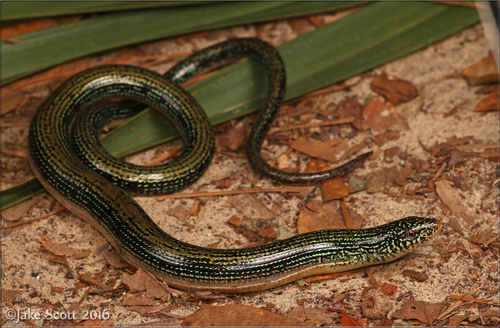
Eastern Glass Lizard
The Eastern Glass Lizard, Ophisaurus ventralis, glides through southeastern U.S. habitats, mimicking a snake. Its legless form and detachable tail aid in predator evasion, while distinctive eyelids and ear openings mark its lizard lineage. It's a vital insectivore, contributing to ecological balance.
10-30 years
Lifespan
311.0 - 595.0 g
Weight
Length: 46 - 109 cm
Size
Brown, Yellow, Black, White, Green
Color
2-3 years
Age of Sexual Maturity
4 mph
Top Speed
Least Concern
Conservation Status
Stable
Population Trend
Characteristics
Ophisaurus ventralis, commonly known as the Eastern Glass Lizard, is a legless lizard native to the southeastern United States. It inhabits grasslands, forests, and wetlands. It has a long, slender body resembling a snake but is distinguished by its movable eyelids and external ear openings. This species has the remarkable ability to autotomize its tail to escape predators, which can then regenerate over time.
Distribution Range of the Eastern Glass Lizard
Ophisaurus ventralis, commonly known as the Eastern Glass Lizard, is native to the southeastern United States. Its geographical distribution includes states such as North Carolina, South Carolina, Georgia, Florida, Alabama, Mississippi, Louisiana, and parts of Tennessee and Kentucky. It is mostly found in the coastal plains and some parts of the Piedmont region.
Eastern Glass Lizard's Habitat
Environmental Conditions
The Eastern Glass Lizard inhabits a variety of environments but is predominantly found in sandy soils with abundant leaf litter. Typical habitats include pine flatwoods, coastal dunes, scrublands, hardwood forests, grasslands, and sometimes in suburban areas. These areas generally have a humid subtropical climate characterized by hot summers and mild winters.
Ecological Niche
Ophisaurus ventralis occupies a niche as a ground-dwelling insectivore in its ecosystem. It feeds primarily on insects, spiders, and other small invertebrates, playing a role in controlling these populations. Its elongated, legless body allows it to move easily through dense vegetation and leaf litter, and it often seeks shelter under logs, rocks, or debris.
Copyright @ Nature Style Limited. All Rights Reserved.
 English
English